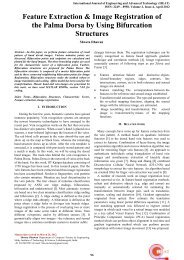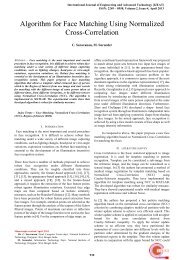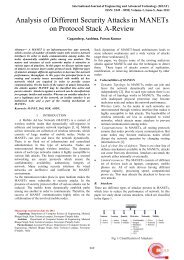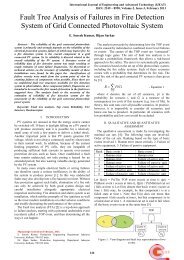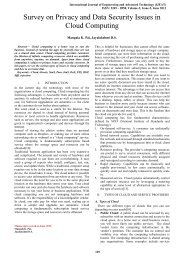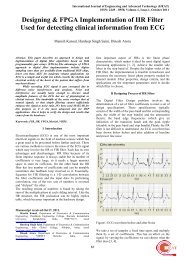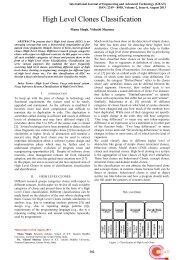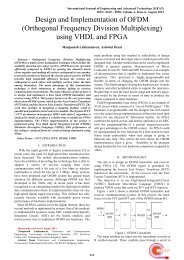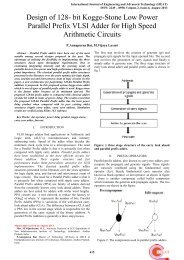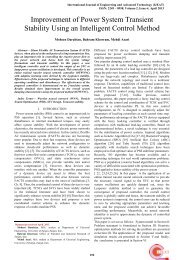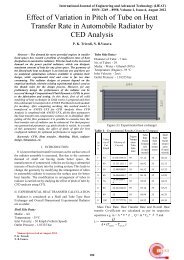Performance Enhancement of Cloud Computing with Clustering
Performance Enhancement of Cloud Computing with Clustering
Performance Enhancement of Cloud Computing with Clustering
You also want an ePaper? Increase the reach of your titles
YUMPU automatically turns print PDFs into web optimized ePapers that Google loves.
<strong>Performance</strong> <strong>Enhancement</strong> <strong>of</strong> <strong>Cloud</strong> <strong>Computing</strong> <strong>with</strong> <strong>Clustering</strong>scientific computing but they may be still good solution forthose that required resources instantly and temporarily.Donglai Zhang et al [2] proposed WSDF framework forimproved data transfer performance <strong>of</strong> web serviceworkflows. This framework allows directly data sharingbetween consecutive web services <strong>with</strong>in a web serviceworkflow. Thus it allows improved performance and betterdata transfer speed between different components <strong>of</strong> aworkflow.Wei Huang et al [3] proposed a framework for performanceand management overheads <strong>with</strong> virtual machines. Two casesare considered: one is Virtual Machine Monitor (VMM)bypass I/O and another is VM image management. VMMbypass I/O extends the OS bypass feature <strong>of</strong> modern highspeed interconnects such as InfiniBand and VM imagemanagement is done <strong>with</strong> three aspects: Customizing smallkernels, developing fast and scalable distribution schemes forlarge scale clusters and VM image caching on computingnodes. Both these cases are having significant performance<strong>with</strong> VMs.Joyent et al [8] has introduced Smart technologies for cloudperformance. These Smart technologies <strong>of</strong>fer enhancedperformance <strong>with</strong> scalability, light weight virtualization,flexible resource provisioning, dynamic load balancing,storage caching and CPU bursting. Scalability <strong>of</strong> cloudenvironment can be improved from its SmartOS operatingsystem, SmartMachine virtualization technology,SmartDataCenter infrastructure management system to itssmartPlatform development environment. According toJoyent, scalability is the best solution to increase theperformance <strong>of</strong> cloud computing environment.III. PROBLEM PERCEIVED IN THIS AREAIt is difficult to match a good definition <strong>of</strong> cloud computingdue to lack <strong>of</strong> standardization and economical impact.Standardizations <strong>of</strong> reliability and security are main concernnow- a- days. Because these issues are facing daily newchallenges. As cloud computing is an on demand service thatshares a pool <strong>of</strong> resources over the network. Thus cloudsecurity and reliability to its users are the major issues to beresearched in this area and both <strong>of</strong> them make it hard tounderstand.In other hand, economical impact <strong>of</strong> cloud allows thatresources could be used in more efficient and intelligent waysby reducing the cost. This can be achieved by virtualizationbecause it requires less storage space <strong>of</strong> the servers and alsoreduction <strong>of</strong> power consumption.Latency and interoperability are also major issues to be solvedin cloud computing because their causes are engineered intothe cloud platforms themselves.One <strong>of</strong> the most important issues in cloud computing is theperformance overhead. Since fast accessing <strong>of</strong> data andresources is highly demanded in cloud environment. Anyorganization adopting cloud computing certainly expect thekind <strong>of</strong> enhanced performance. But this performance isdegraded due to limited bandwidth, high response time,inefficient CPU & memory utilization, scalability bottleneckand unnecessary use <strong>of</strong> data centers.I/O virtualization poses a more difficult problem because I/Odevices are shared among all virtual. It requires a privilegedomain from guest VMs to access I/O. This intervention leadsto longer I/O latency and higher CPU overhead due to contextswitches between the guest VMS and VMM (Virtual MachineMonitor). <strong>Performance</strong> <strong>of</strong> cloud computing is also dependenton the underlying cloud infrastructure.IV. PROPOSED METHODOLOGY<strong>Performance</strong> is the major concern in the field <strong>of</strong> cloudcomputing. People are running into the scalability. Butincreasing number <strong>of</strong> Virtual machine and CPU is not the keysolution for scalability, because cost is another issue to beresearched then. So the area which is identified for improvingthe performance is to avoid the unnecessary use <strong>of</strong> databases.Data centers are highly loaded for accessing I/O requests.Although operations on huge amount <strong>of</strong> data in cloudcomputing are quite complex and lead to be performanceoverheads. There may be a case <strong>of</strong> server failure. So from thedevelopment, maintenance and performance perspective, allthese can be serious issues to be refined. One <strong>of</strong> the solutionsis to allow highly available data in the cluster form. Thusreplicas are available at each data centers and are highlyavailable. In our work, the I/O parameters are chosen forincreasing the performance in this domain. This enhancementcan be achieved through the clustering and cachingtechnologies.Cluster based data centers are highly efficient for performingI/O operations. Clusters can be defined as collection <strong>of</strong> virtualdata servers and are treated as a single machine. <strong>Clustering</strong>avoids uninterrupted access to data and also helps whennetwork or storage connectivity is lost. Caching, in otherhand, prevents over hits to the databases. Network cachingand VM image caching are the two aspects that are proposedfor this purpose. Thus the idea behind both these technologiesis to minimize the information that move among the differentcloud components. Although clustering can be done atdifferent level such as OS level, Application level, web serverlevel and database level.<strong>Clustering</strong> among the data centers that are located throughoutthe world, allow highly available data for customers <strong>with</strong>outany delay. Thus if one data center is goes down, everything inthe second data center is clustered <strong>with</strong> the first, so there is noproblem for the time being. And you still havedatabase/web/app server in the second data center.In the favour <strong>of</strong> our work several issues are identified forbetter performance <strong>of</strong> cloud services. In some previousstudies it is established that clustering can be a keycontributing factor to improve the performance in cloudcomputing.G.Malathy et al [1] proposed the Reservation Clusterapproach for performance enhancement in cloud computing.The concept <strong>of</strong> reservation cluster is to schedule the tasks.Unscheduled tasks are sent to the reservation cluster and inthis cluster all the tasks are scheduled simultaneously <strong>with</strong>outany iteration. It reduces the amount <strong>of</strong> computation time andresource usage and allows better performance.A.Mahendiran et al [10] proposed the implementation <strong>of</strong>K-Means clustering algorithm in cloud computing for largedata sets. The work was focused to implement and deployK-Means algorithm in Google <strong>Cloud</strong> using Google AppEngine <strong>with</strong> cloud SQL. Thus cloud computing allows mining<strong>of</strong> large databases and storing them <strong>with</strong> less cost. Resultsshow that clustering works well in the cloud.Since cloud is having the large data sets and these data sets areregularly accessed as per user requirements. Michael Shindleret al [11] have proposed fast and accurate k means algorithmas a solution where the data is too large and must be accessed190



